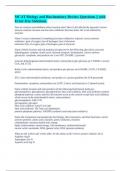MCAT Biology and Biochemistry Review Questions || with
Error-free Solutions.
How do catalysts and inhibitors affect reaction rates? How is ∆G affected by enzymes? correct
answers catalysts increase reaction rates; inhibitors decrease them. ∆G is not affected by
enzymes
Name 3 ways to determine if something has been oxidized or reduced. correct answers
oxidation= gain of oxygen, loss of hydrogen, loss of electrons
reduction=loss of oxygen, gain of hydrogen, gain of electrons
Name cellular location and end products per glucose for the following: glycolysis, pyruvate
dehydrogenase complex, Krebs cycle, electron transport, fermentation. correct answers
glycolysis: cytoplasm, end products are 2 net ATP, 2NADH, 2 pyruvate
pyruvate dehydrogenase:mitochondrial matrix; end products (per glucose) are 2 NADH, 2 acetyl-
CoA, and 2 CO2
Krebs Cycle: mitochondrial matrix, end products per glucose are 6 NADH, 2 GTP, 2 FADH2,
4CO2
ETC: inner mitochondrial membrane, end product is a proton gradient (30 ATP generated)
Fermentation: cytoplasm, end products are 2ATP, 2 lactic acid (muscle) or 2 ethanol (yeast)
Name cellular location and main products of the following biochemical pathways:
gluconeogenesis, glycogenesis, glycogenolysis, fatty acid oxidation, fatty acid synthesis, pentose
phosphate pathway. correct answers all reactions occur in the cytosol except fatty acid oxidation,
which occurs in the mitochondrial matrix. main products:
gluconeogenesis: G6P, G1P
glycogenesis: glycogen
fatty acid oxidation: acetyl CoA units
fatty acid synthesis: 16C fatty acid (palmitate)
pentose phosphate pathway: NADPH (oxidative) and rubp (non-oxidative)
Name the 4 important macromolecules for biology, their monomers, and their functions. correct
answers proteins: amino acid; channels, pores, hormones, enzymes
carbohydrates: monosaccharide unit; energy
lipids: hydrocarbons; stored energy, cell membranes, cholesterol/steroids
nucleic acids: nucleotide, DNA (genetic info), RNA (protein synthesis)
What are the 3-letter and 1-letter abbr. for the amino acids? correct answers Alanine Ala A
Arginine Arg R
Asparagine Asn N
Aspartic acid Asp D
,Cysteine Cys C
Glutamic acid Glu E
Glutamine Gln Q
Glycine Gly G
Histidine His H
Isoleucine Ile I
Leucine Leu L
Lysine Lys K
Methionine Met M
Phenylalanine Phe F
Proline Pro P
Serine Ser S
Threonine Thr T
Tryptophan Trp W
Tyrosine Tyr Y
Valine Val V
Sort the amino acids into groups with polar, nonpolar, acidic and basic side chains. What is
unique about the structure of proline? correct answers Polar: asparagine, cysteine, glutamine,
serine, threonine, tyrosine
nonpolar: alanine, glycine, isoleucine, leucine, methionine, phenylalanine, proline, tryptophan,
valine
acidic: aspartic acid, glutamic acid
basic: arginine, histidine, lysine
proline unique because its amino group is covalently bound to its nonpolar side chain, creating a
secondary alpha amino group and a distinctive ring structure. important consequences for folding
What is the central dogma of molecular biology? correct answers DNA-->RNA-->protein
Define replication, transcription and translation. At which stage is protein synthesis primarily
regulated? correct answers replication: DNA to DNA
transcription: DNA to RNA (regulation of protein synth)
translation: RNA to protein
What does semiconservative replication mean? correct answers after DNA replication, one strand
of a DNA double helix is composed of old DNA and the other is composed of newly-synthesized
DNA
What are the differences between DNA and RNA? Name the three types of RNA and their
functions. correct answers DNA: double stranded, AGCT, sugar deoxyribose
RNA: single stranded, AGCU, sugar ribose
mRNA: translated to make proteins
rRNA: needed to make a functional ribosome
tRNA: carries an aa to a ribosome to be incorporated into a growing protein
, Name at least five differences between prokaryotes and eukaryotes. correct answers prokaryotes:
no nucleus or organelles; single circular chromosome; 3 different DNA polymerases and 1 RNA
pol; transcription and translation simultaneous, mRNA is polycistronic; no mRNA processing
eukaryotes: nucleus and other organelles; several linear chromosomes; 1 DNA polymerase and 3
different RNA polymerases; mRNA is monocistronic; mRNA must be processed before
translation
What is the basic structure of a virus? correct answers a virus is a piece of nucleic acid
surrounded by a protein shell (capsid)
Name the three different life cycles of a virus. Which of these is an animal virus life cycle only?
correct answers lytic, lysogenic, productive (animal virus life only)
What is a prion? What is a viroid? correct answers prion: abnormally folded version of a normal
protein that is able to cover other normal prions to its abnormal form; highly resistant to
degradation by heat, acids, etc and are implicated in degenerative brain disorders (creutzfeld
jakob, BSE)
viroid: short, single stranded RNAs that have highly complementary sequences; plant pathogens
that are thought to affect protein synthesis by binding to and silencing normal cellular RNAs
Name the three shapes of bacteria correct answers round (coccus), rod-shaped (bacillus), spiral
(spirochete)
Define obligate aerobe, facultative anaerobe, tolerant anaerobe, and obligate anaerobe. correct
answers obligate aerobe: must use O2 to survive
facultative anaerobe: prefers O2 but can survive by fermentation if no O2 present
tolerant anaerobe: does no use O2 but is not poisoned by O2
obligate anaerobe: only survives in absence of O2
Name the cell organelles and their functions. correct answers nucleus: control center, contains
DNA, site of replication and transcription
ribosome: protein synthesis
rough ER: holds ribosomes that are synthesizing secreted or membrane proteins, protein
modification
golgi apparatus: sorts and packages proteins, protein modification
lysosome: digestive enzyme container
mitochondria: energy production
smooth ER: lipid metabolism
Centrosome: mitotic spindle formation
peroxisome: eliminates free radicals
Name the four main colligative properties. What do they depend on? correct answers vapor
pressure depression, boiling point elevation, freezing point depression, osmotic pressure; depend
only on the number of solute particles in a solution and not on the type of particle




